There is something to say about the many types of Korean noodles and all the rich cultures they encapsulate. There is a type of noodle for every mood, every kind of weather. Korean people are master adapters to their environment, and their noodle culture is proof.
When you think of Korean noodles, you may think of black bean noodles or Japchae – a Korean noodle side dish. I am here to enlighten you with many more noodle dishes you can try when you find yourself in Seoul or other parts of South Korea.
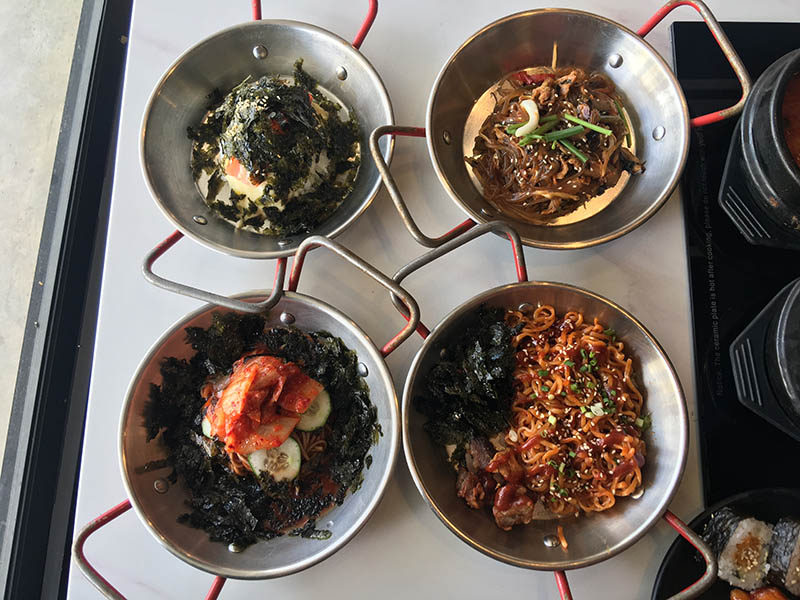
Different Types Of Noodles Koreans Use In Noodle Dishes
You can’t possibly make all the types of Korean noodles dishes with just one type of noodle. Different noodle dishes require different textures and different flavors. This is a list of common noodles that you can find in a Korean pantry.
1. Dangmyeon – 당면 (Cellophane Noodle)
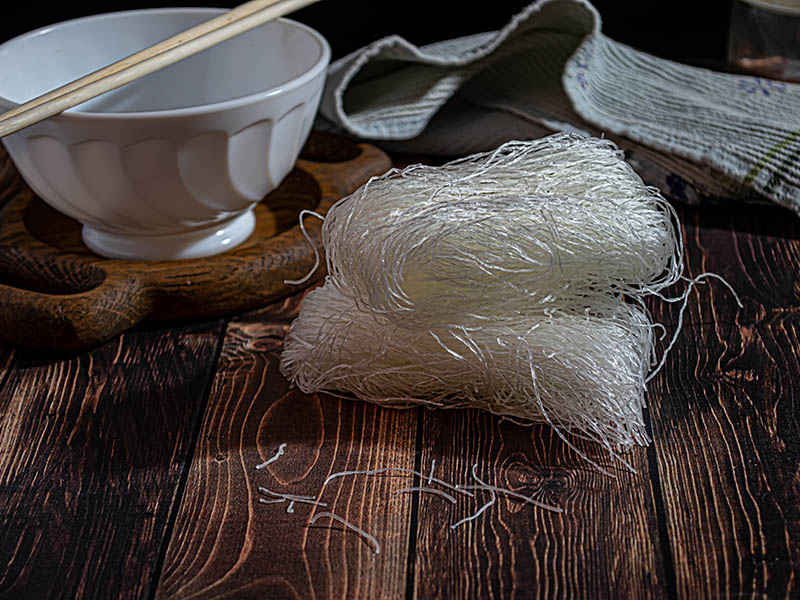
Cellophane noodles are a classification of noodles with a distinctive translucence quality. Dangmyeon and other noodles of the same variety sometimes have the name “glass noodles” because it looks like spun glass when cooked.
Though cellophane noodles usually contain starchy powders such as mung bean, potato, or tapioca, the Korean version uses the starch from sweet potatoes. The sweet potatoes impart a lightly golden hue to the dried Dangmyeon.
People often associate cellophane noodles with Japchae. Its culinary uses are much more diverse. You may even recognize Dangmyeon in one of Korea’s most famous street foods, Soondae, Korean blood sausages.
2. Naengmyeon – 메밀국수 (Buckwheat Noodle)
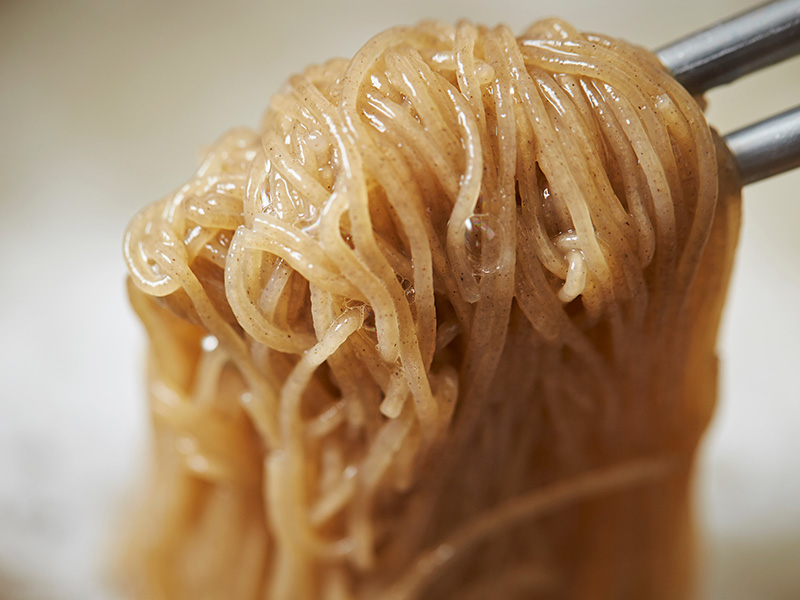
The Korean buckwheat noodle has the name “Naengmyeon”. Besides buckwheat flour, the Naengmyeon noodle sometimes includes starches from potatoes, Kudzu, and arrowroot. It is the arrowroot element that makes Naengmyeon’s color a bit darker.
Korean home cooks and professional chefs use buckwheat noodles in many hot and cold Korean dishes. These chewy noodle strands are usually paired with a hearty and savory broth. They are a perfect combo to eat regardless of your mood.
“Naengmyeon” doesn’t simply refer to the type of noodle made from buckwheat. The name also describes an entire cold noodle dish that has been considered a Korean staple. Another variety of Naengmyeon is called Memil Guksu, which follows the same premise of preparation.
Ice cold noodle is an instant hit in the South Korean food scene.
3. Jjolmyeon – 쫄면 (Wheat Noodles)
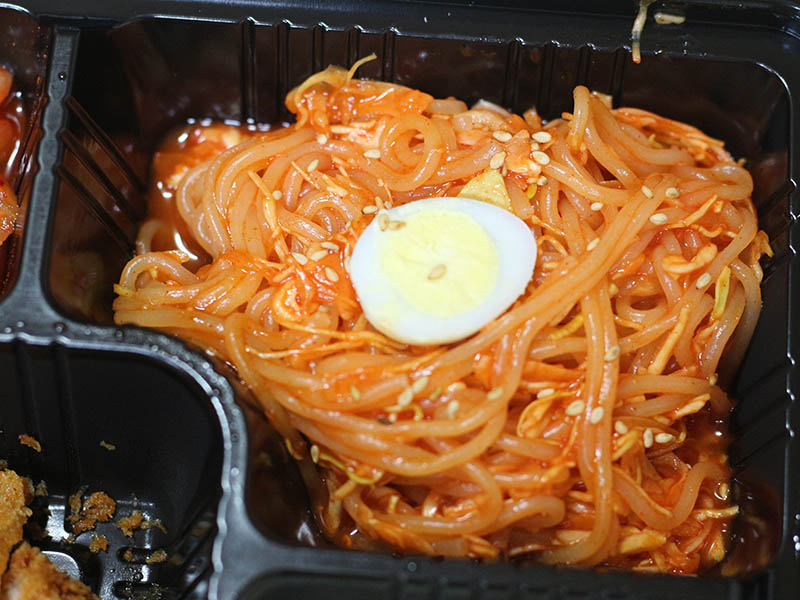
Jjolmyeon is the joint name of the chewy wheat noodle and is also a spicy cold noodle dish adored in South Korea. Jjolmyeon has a unique origin story compared to the other types of noodles used in Korean cooking.
Jjolmyeon was originally a mistake when a Naengmyeon noodle factory produced noodles of the wrong size. Instead of throwing the defects, the more giant chewy noodles mix well with Gochujang to produce the spicy Jjolmyeon dish.
The chewiness is a result of the way factories manufacture Jjolmyeon. Machines heat the Jjolmyeon dough to 150℃, which is when the dough goes through an extrusion process into long strands of chewy noodles.
4. Cheonsachae – 천사채 (Kelp Noodle)
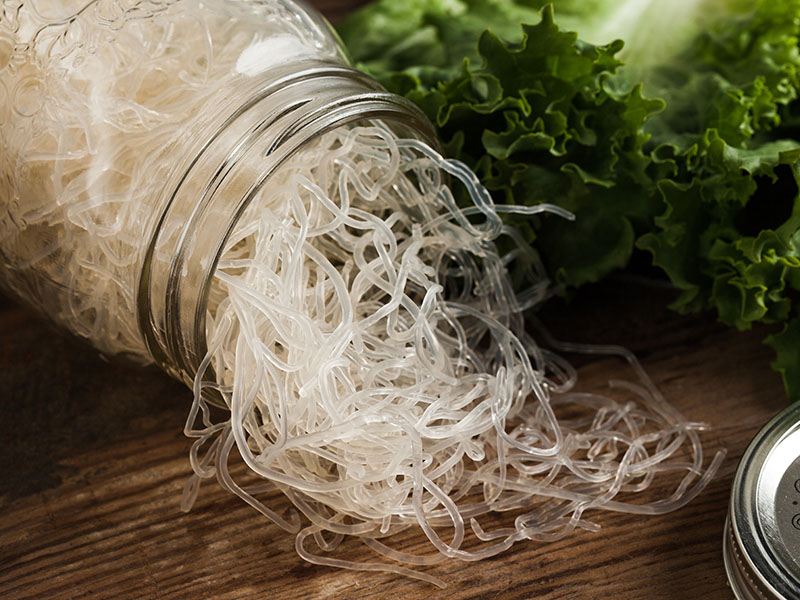
Korean kelp noodles or “Cheonsachae” are becoming increasingly desirable as the world inches closer to the vegan and gluten-free diet trends. Cheonsachae is what’s left over after a jelly-like extract after steaming kelps.
The exceptional quality of Cheonsachae is that it does not include any additional flour or starches in its ingredients. Many Asian countries and cuisines have gotten used to including Cheonsachae in their cooking.
Cheonsachae is best when it is raw to preserve its fresh, savory, and crispy texture. But Korean recipes have adapted Cheonsachae into soupy dishes by cooking the kelp noodles in a mixture of water and spices.
5. Somyeon – 소면 (Somen Noodle)
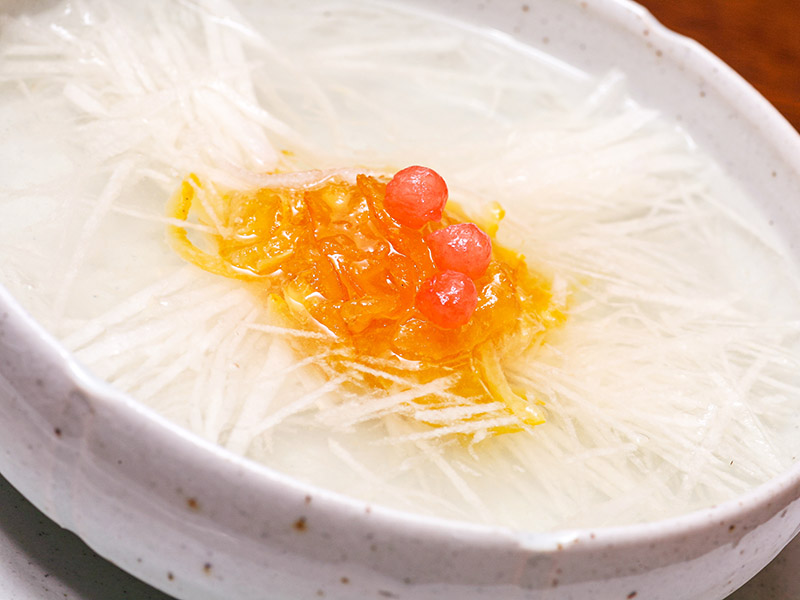
Many people will often associate Somyeon noodles with their popularity in Japanese cuisine. The noodle has a Chinese origin and bears the name “Sùmiàn”. This type of noodle usually has a high starch quantity from wheat and has a diameter of less than 1.3 mm.
One thing to note about cooking Somyeon is to be mindful of the cooking time. They overcook very quickly. In Korean culture, Somyeon is popular with cold or hot applications. From now on, you may recognize Somyeon in dishes such as Kongguksu and Janchi-Guksu.
The structural integrity of this wheat noodle is rather delicate and requires a very short cooking time. After boiling to rehydrate and cook Someyeon, It is important to rinse the noodle in some cold water to stop the cooking and prevent the noodle from becoming mushy.
Cold Noodles Should Be Your New Preference
If you are like me, you would immediately think of a steaming bowl of soupy noodles when you think of a Korean noodle dish. The fact is that Koreans usually prefer their noodle dishes ice cold to refresh the body when the temperature gets too high.
It is one of the many things to love about Korean cuisine. You can always expect the unexpected. Whether the noodles have a soupy broth or not, these noodle dishes are cooling and satisfying to eat in the summer heat.
1. Kongguksu – 콩국수 (Cold Soy Milk Noodle Soup)
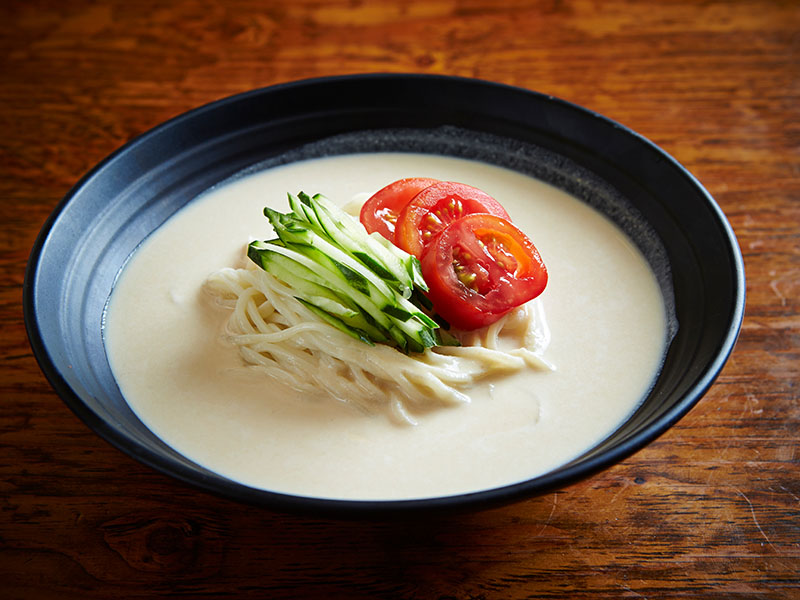
It is uncertain when Kongguksu got its name in the Korean language. “Kong” means soybean, and “guksu” means noodle soup. It is not ideal to use the grocery-store soy milk to prepare Kongguksu since it might be too sweet. Instead, make your own soy milk.
The basics of Kongguksu only have a few ingredients. The main components are thin wheat noodles, thick and savory soy milk, and some freshly julienned vegetables to add texture and freshness.
Kongguksu is usually available in the summertime to cool down the body. The secret to a good Kongguksu is smooth and cold soy milk. You should make soy milk since the ones at the store are too loose.
When the weather gets hot, people seek out Kongguksu.
2. Bibim Guksu – 김치 비빔 국수 (Spicy Mixed Cold Noodles)

Bibim Guksu, sometimes referred to as “Goldong Myeon”, translates to “mixed noodle” or “stirred noodle”. In the summertime, the heat inspired this cold noodle dish that includes skinny wheat noodles mixed with various fresh vegetables and spices.
Bibim Guksu uses beef and a boiled egg as its primary protein and fatty acid source. The flavoring of this dish comes from sesame oil, red pepper paste (Gochujang), and soy sauce. Julienned cucumber enhances the entire dish with its incredibly crisp texture.
Spicy mixed cold noodles are a must for spice lovers all around Korea despite the intense summer heat. The spiciness even sets Bibim Guksu apart from other types of Korean cold noodles. You can eat this dish with or without some cold beef broth.
3. Bibim Jjolmyeon – 쫄면 (Korean Spicy Chewy Noodles)
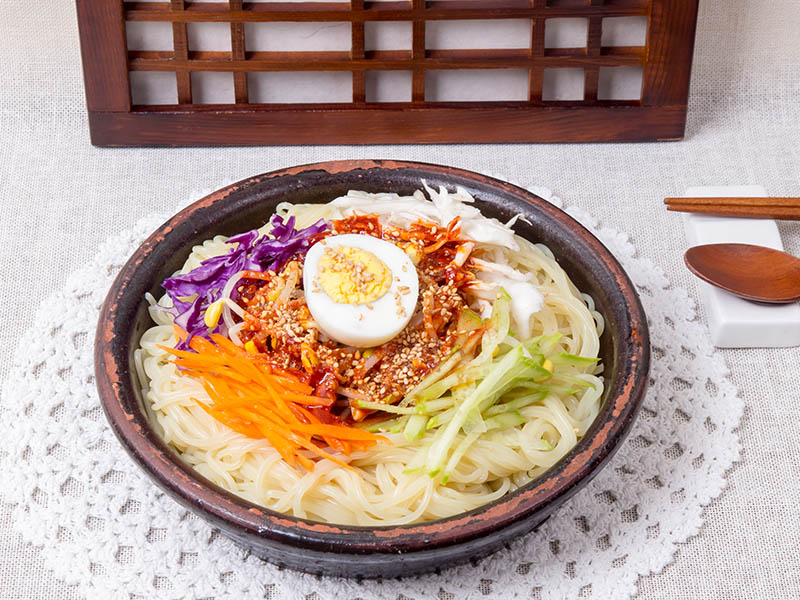
Bibim Jjolmyeon originated and is representative of the Incheon region in Korea. In 1970, after a happy accident, Jjolmyeon became an instant favorite. “Jjol” means chewy, and ”myeon” means noodle. Those words would describe this dish.
Spicy, tangy, zesty, and savory, everything you can look for in a noodle dish is all present in the Bibim Jjolmyeon. This noodle dish “Bibim Jjolmyeon” develops upon the thick, chewy noodles of the same name. It’s truly a refreshing meal to have in Korea.
In Korea, snack bars – “Bunsikjip” – were the first to turn the thick, chewy Jjolmyeon into the spicy mixed noodles known as Bibim Jjolmyeon. Jjolmyeon is popular among the young people of South Korea because it is relatively much cheaper.
4. Mul Naengmyeon – 물냉면 (Korean Cold Noodles in Broth)
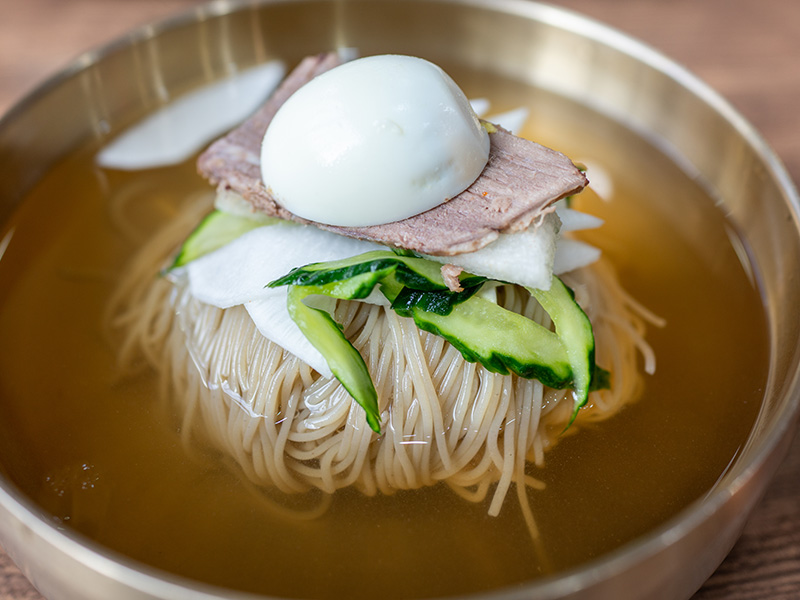
Historic records imply that Mul Naengmyeon was once the typical winter food of Korea. However, the modern application of Mul Naengmyeon is more suitable for the summertime since it tastes extremely pleasant in chilled beef broth.
Korean restaurants often serve Mul Naengmyeon in metal bowls to highlight the broth’s coldness. This dish originated in the northern part of Korea back in the 19th century. After the Korean war, Naengmyeon became more integrated into South Korean cuisine.
A Dongchimi-inspired broth (Dongchimi is quickly fermented radishes) sets the flavor for Mul Naengmyeon. While North Koreans prefer their Mul Naengmyeon with a sprinkle of sugar, South Koreans exclusively use beef broth.
5. Makguksu – 막국수 (Chilled Buckwheat Noodles)

What happens when you put chewy buckwheat noodles in a cold savory broth with crispy fresh vegetables? You make Makguksu. “Mak” means “just” or “just now”, which refers to the process of taking freshly pressed buckwheat noodles and making a noodle soup with them.
The reason why I said “pressed” and not “hand-rolled” or “handmade” is because the buckwheat noodle used to make Makguksu doesn’t have any gluten. The lack of gluten protein makes it harder to knead manually and cut out the noodle by hand.
The broth has many versions that vary from household to household. Some prefer the clean taste of the chicken broth, whereas others may prefer to have an anchovies-inspired broth. But one common thing they all have is the ice-cold broth with fresh vegetables.
Learn more about Makguksu and how you can make it at home.
6. Bibim Naengmyeon – 비빔냉면 (Korean No-Broth Spicy Cold Noodles)
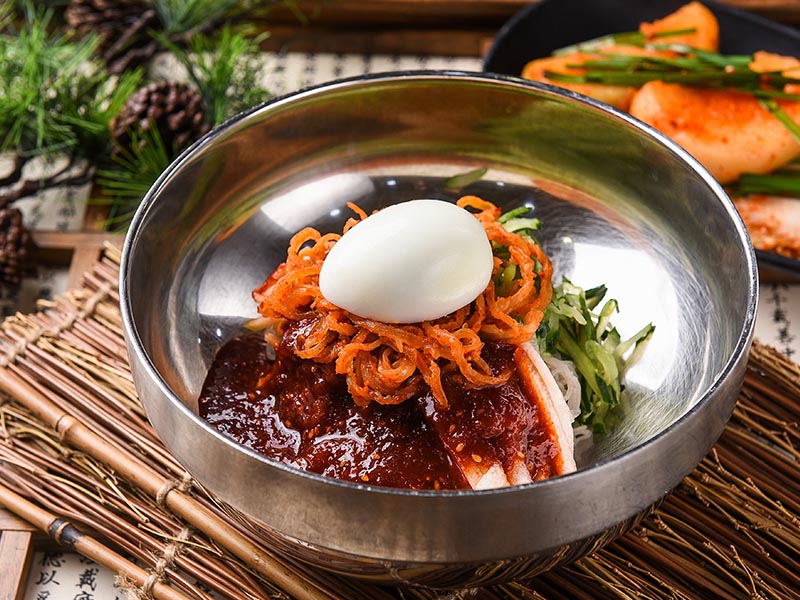
The brother of the previously discussed Mul Naengmyeon, Bibim Naengmyeon, is the peppery counterpart that is the favorite of spice-loving people. Where Mul Naengmyeon comes in a chilled broth, Bibim Naengmyeon has the broth on the side.
The heat mostly comes from the Gochujang, which contributes depth and complexity to the dish’s flavor profile. One element that isn’t missing in this dish is the julienned crunchy vegetables.
Bibim Naengmyeon tastes slightly sweet with bright acidity from the vinegar. The cook will wash the noodle to remove all the starch and set it in the bowl. The sauce and toppings may vary from family to family. The first thing you do before eating is to mix the noodles up.
7. Kimchimari Guksu – 김치말이국수 (Cold Kimchi Noodle Soup)
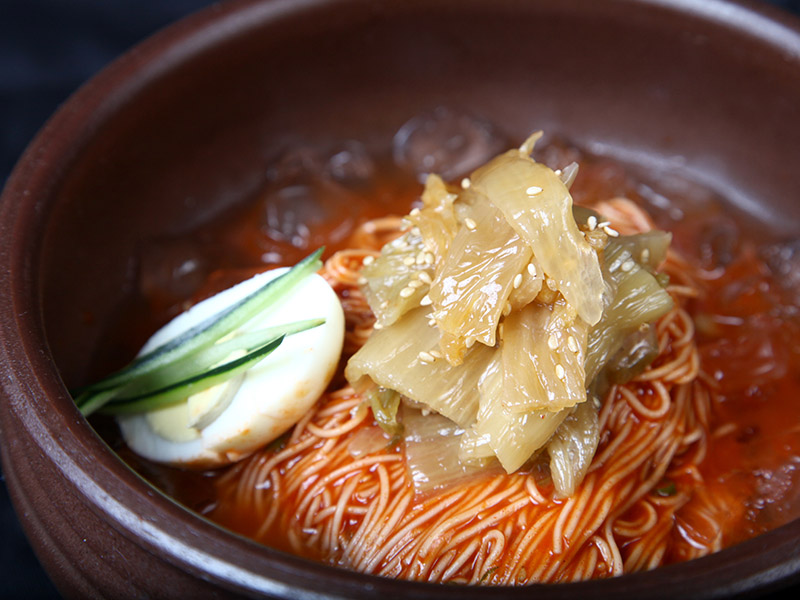
The term Kimchimari refers to the act of mixing something with Kimchi. So it makes sense that when a soup has a Kimchi broth and a mixture of assorted vegetables, its name is“Kimchimari Guksu”.
Kimchimari Guksu utilizes the chewiness of buckwheat noodles (flash-cooled in an ice bath after boiling) as the dish’s focus. When a Korean home has overripe Kimchi that has become a bit too sour, this is usually the dish they like to make.
The lactic acid in the Kimchi makes the broth fragrant and tangy. The acidity helps restore one’s appetite when the heat becomes too much. Like the Naengmyeon, the Kimchi broth has time to chill before pouring onto the noodle.
Crank Up The Spice For These Warm Noodle Dishes
One thing better than how Koreans enjoy their noodles cold is how they enjoy their noodles hot. The Korean approach to noodle broth will redefine your definition of flavor. Usually consisting of only a few simple ingredients simmered for a long time, the broth is pleasantly rich.
A warm bowl of noodles is synonymous with a good time, and you can always count on the complexity of these noodle dishes to keep you wanting more. Find out if you have ever tried these noodle dishes and learn more about Korean noodles.
8. Janchi Guksu – 김치말이국수 (Banquet Noodle)

A more common name you may recognize as “Janchi Guksu” is “Banquet noodles”. The name describes this cold noodle dish that appears on special occasions or holidays. It is easy to make and can please almost anyone.
There is even a famous saying in Korean culture that alludes to “when are you getting married” by asking, “when are you going to feed us Guksu”. This is because the wedding-goers go wild for the chewy noodles and the light anchovy broth.
Many versions of Janchi Guksu exist. The standard toppings found on the “Janchi Guksu” are julienned vegetables, cut fried eggs, and seaweed (Gim). There is a possibility to substitute the anchovies broth with beef broth or kelp broth.
There is a sense of deep culture associated with Janchi Guksu.
9. Kalguksu – 칼국수 (Knife-Cut Noodle)
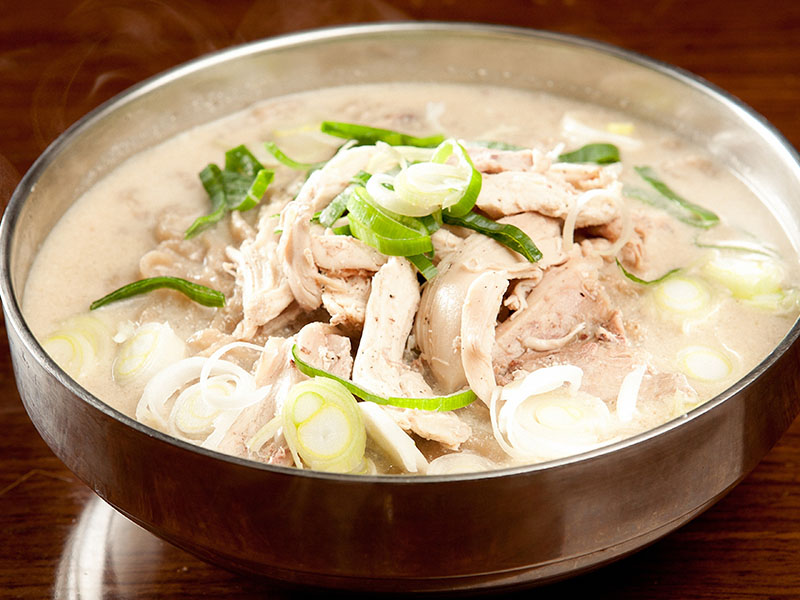
The story of Kalguksu started very far back, but its records weren’t clear until the 1920s. Kalguksu is not like other noodle dishes. It is made from scratch through and through. The preparation process of this noodle dish takes time and much effort to get just right.
Traditionally, Kalguksu is a noodle dish for special occasions due to the high price of wheat flour, making noodles an overall luxurious item. Nowadays, knife-cut noodles are more popular and have the addition of ground bean powder to improve texture.
The broth of Kalguksu requires long, slow, and low cooking to draw out all of the ingredients’ natural flavors. Old recipes instruct that the noodles be boiled until cooked and rinsed with cold water. Modern cooks will just simmer the broth, vegetables, and noodles together.
10. Jjamppong – 짬뽕 (Spicy Seafood Noodle)
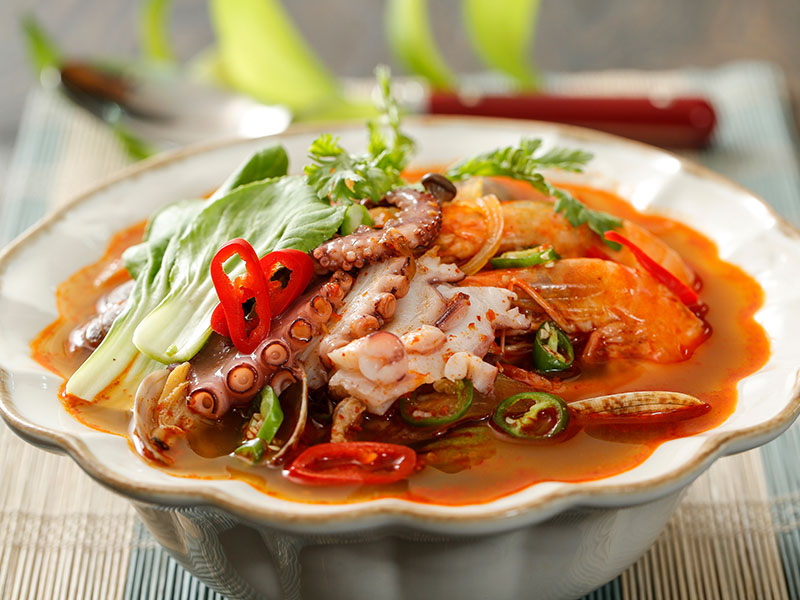
Do you love the savoriness of the amazing Korean pancake with seafood Haemul Jeon? How about experiencing that sensation in another form, say, a bowl of heat-packed noodles with all the seafood delights you can eat? Let’s try Jjamppong!.
It stems from the Chinese “Chǎomǎmiàn”. But when the Japanese settled in Korea, they saw how similar Jjamppong was to the Japanese “Champon”, which is why the name caught on. Korean dialect warped the “Champon” into “Jjamppong”.
Jjampong is warm and filled with delicious flavors. The noodles are usually thick and stringy, submerged in a rich red broth made from pork or seafood. Familiar combinations usually include julienned vegetables and sliced pork or mussels.
Though Jjamppong got its footing from the Chinese Korean restaurants, it has quickly become a nationally renowned noodle soup with spicy and savory flavors. You can have it with the broth or without. The dry mixed version isn’t any less delicious.
11. Sujebi- 수제비 (Hand Pulled Dough Soup)
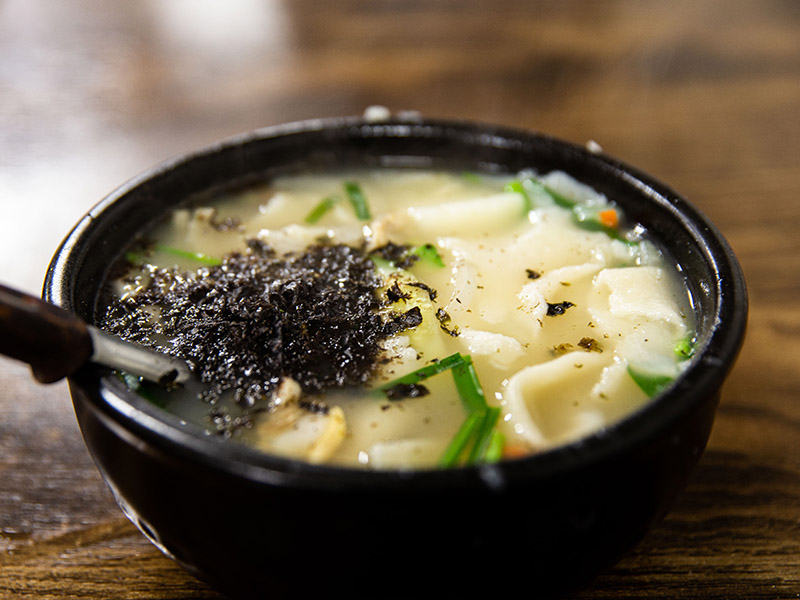
Sujebi is a cousin of Kalguksu, with the main difference being the shape and size of the noodles. You may not think that Sujebi is a type of Korean noodle because you can’t see the familiar long strands, but the roughly torn noodle pieces are even better.
The dough for the noodle of Sujebi has only a handful of ingredients. The chef will make a dough out of wheat flour and knead it until it becomes smooth and elastic. The cook will then hand tear the dough into irregular pieces and drop them into the boiling broth.
The broth for Sujebi has the same formula as the broth for Kalguksu. The main flavor profiles are anchovies, kelp, and other types of shellfishes. When the noodles hit the boiling broth, they need a long simmer to become tender and soak up all the flavors of the broth.
12. Jajangmyeon – 짜장면 (Black Bean Noodle)
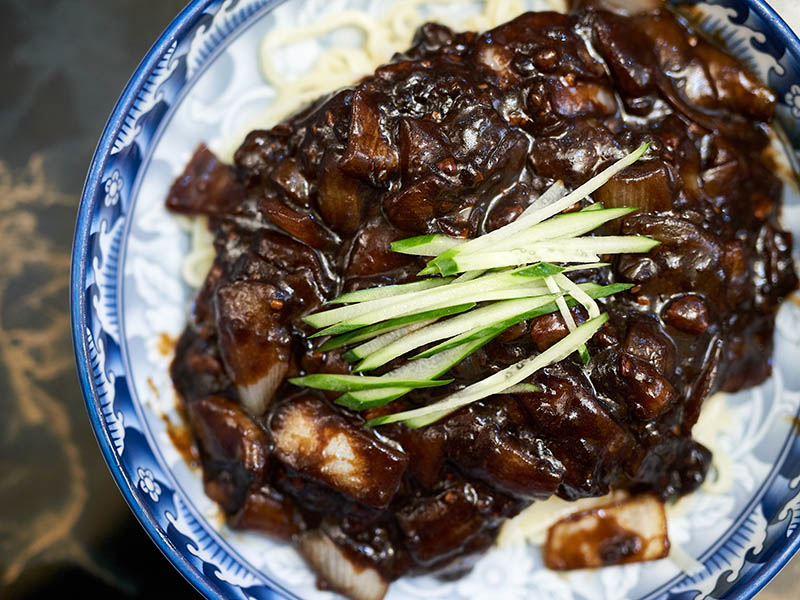
This is another noodle dish that bears the marks of its Chinese influence. The term “Jjajang” got its root from the Chinese “Zhájiàng”, meaning “fried sauce”. This is accurately the identifying feature of this noodle dish.
As an homage to its Chinese heritage, the noodle used in Jajangmyeon is “Cumian”- a thick Chinese alkaline noodle that gets its shine from baking soda. The sauce of Jjajangmyeon comes together by frying fermented bean sauce with other ingredients.
The bean sauce has a natural reddish-brown color that is the signature look of Jajangmyeon. Popular toppings in the sauce include cucumbers, eggs, and scallion. The flavor is quite distinctly nutty and savory, which is probably why people love it so much.
Jajangmyeon is one of the must-eat Korean noodle dishes for beginners.
13. Budae-Jjigae – 부대찌개 (Army Stew)
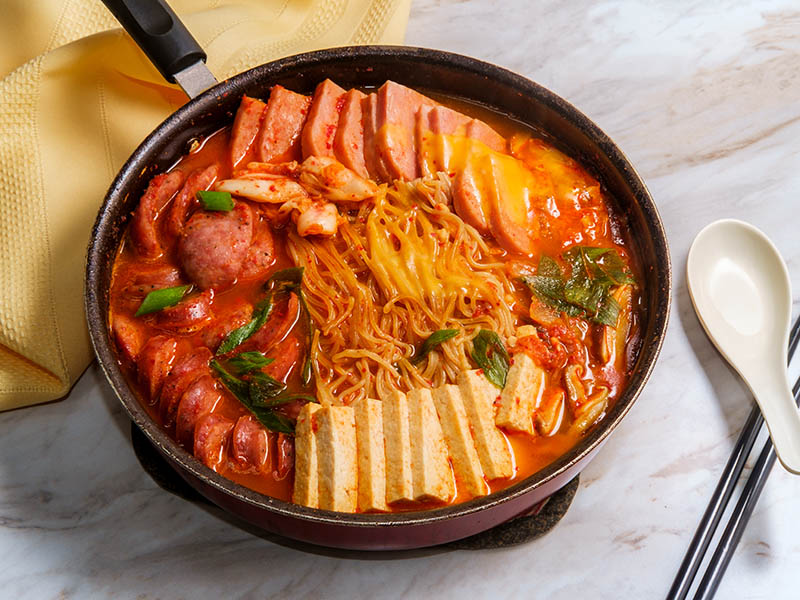
The history of Budae-Jjigae is an arduous one. During the Korean War, food was scarce and hard to find. When people dwelled close to the U.S army base, they adapted to the situation by using the food surpluses that were available to them.
It is here that Budae-Jjigae originated. “Budae” means army, and “Jjigae” is a classification of soup thicker than Guksu. The main components of Budae-Jjigae consist of shelf-stable ingredients such as spam, instant noodles, and baked beans.
After the armistice that halted the Korean war, Budae-Jjigae continued to become more prevalent in all of Korea. Nowadays, you will see Budae-Jjigae served as a type of “Anju” (Korean food served with alcohol).
14. Jjapaguri – 짜파구리 (Ram-Don)

Enough with the gourmet noodles. Sometimes you just want something instant and cheap. Jjapaguri is the answer to saving money and to having a comforting meal to eat when payday is still far away.
The name “Jjapaguri” or “Chapaguri” combines two names, “Chapagetti” and “Neoguri”, which are two cheap Korean instant noodles by the Nongshim brand. This dish is just simply the combination of these two types of noodles.
After gaining worldwide recognition with the help of South Korean media, Jjapaguri or “Chapaguri” has taken on the name “Ram-Don” to make it easier to pronounce for international consumers. Nongshim even began to manufacture and sell Chapaguri instant noodles.
Taste-testing the famous Jjapaguri, does it live up to the hype?
Noodles Are Also Popular As A Korean Side Dish
In all the categories of Korean cuisine, Banchan is the simplest yet most complex component to get right. Banchan refers to the various Korean side dishes eaten alongside rice and many other savory dishes. Banchan also includes noodles.
Korean families and restaurants usually serve this noodle dish as a side dish. You can enjoy this stir-fried glass noodle on its own or with rice and other meat dishes.
15. Japchae – 잡채 – (Glass Noodle Stir-Fry)
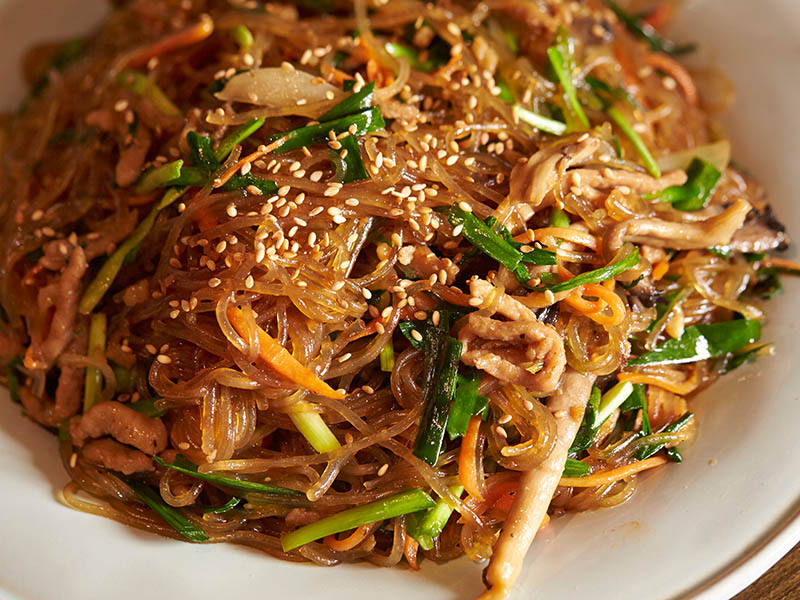
When you type in “Korean noodle side dish” to any search engine, you will almost always find Japchae dominating all the lists. It has been a Korean staple for as long as many Koreans can remember, and it will continue to bring its deliciousness to many generations to come.
The name “Jap” means mixed, and “Chae” refers to an assortment of vegetables. The name etymology reflects the historical version of Japchae which was only various vegetables stir-fried with mushrooms.
The addition of a semi-translucent cellophane noodle belongs to the modern era. However, this version has been around so long and gained so much popularity that people rarely prefer the vegetable-only version.
The Familiarity Of Korean Instant Noodles Is Pure Comfort
Korean instant noodle culture is hard to compete with. They utilize the best combination of flavors with chewy noodles. I am sure many students far from home have come across and enjoyed at least one of these noodle brands. Do you recognize any?
16. Samyang – 삼양식품
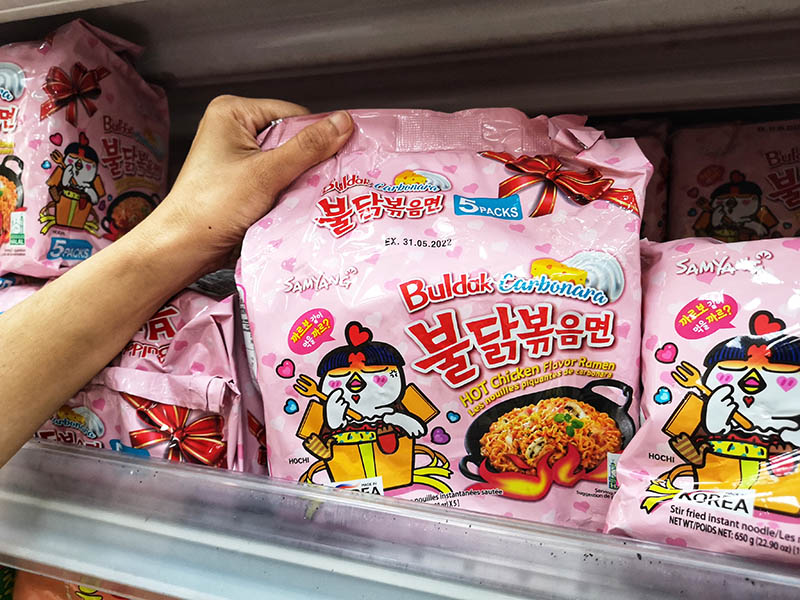
Samyang is a famous brand of Korean instant ramen that is internationally renowned for its varieties. A little trivia fact for Korean noodle lovers is that Samyang Ltd. pioneered the first instant noodles in Korea.
Samyang has been a comprehensive food company for a long time. The company set up multiple farms around Korea to raise meat and grow food to serve as ingredients in their noodles. So you can be sure that Samyang noodles are safely sourced.
17. Nongshim – 농심
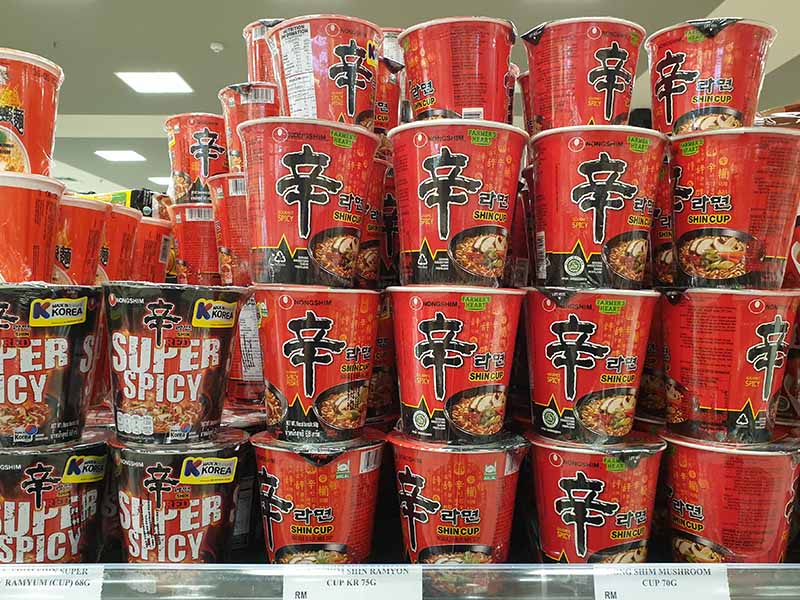
Nongshim International has produced many of your favorite instant noodles, including those making up the Chapaguri I mentioned above. Nongshim is not only a fan favorite in South Korea, but the quality speaks volumes in international markets.
Not only has Nongshim played an integral part in introducing Korean food to the world, but the company also wants to give back. In 2018, all domestic Nongshim factories earned the company’s green certification.
As of 2020, the New York Times elected “Nongshim Shin Ramyun Black” to be the world’s best instant noodles.
Try this tip to get your Nongshim noodle perfect.
18. Paldo – 팔도
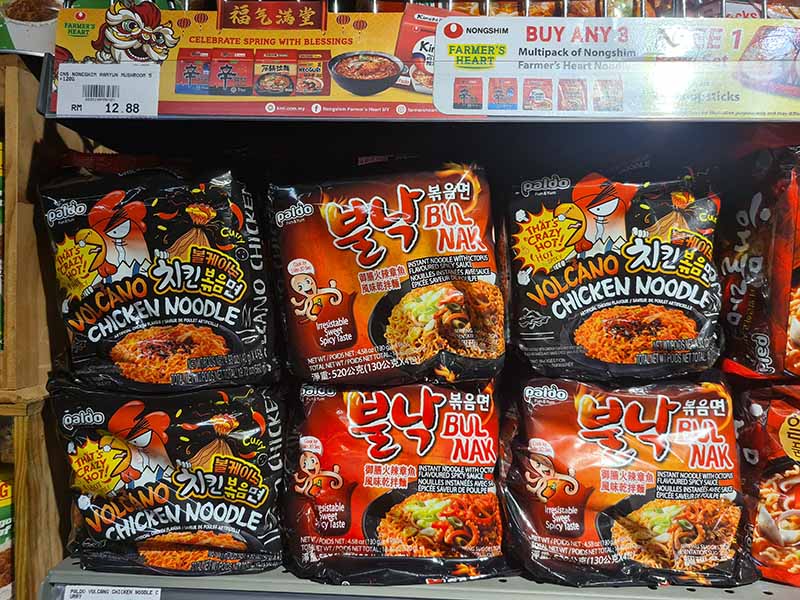
With exported products integrated into more than 70 countries, this is evidence of the continuous and prosperous growth of the company. The majority of these products are instant noodles and various beverages in Korea.
Advertised as Korea’s leading brand in instant noodles, the Paldo instant-food company has grown and set roots in many Southeast Asian countries. The Paldo square Dosirak noodle has been successful in countries such as China, Japan, and Russia.
Koreans Have Perfected Many Types Of Noodles
Hot, cold, or instant ramen, Korean noodles have successfully defended their place in the hearts of people all across the globe. You have learned so much about all the types of Korean noodles, but you have only just scratched the surface.
It takes time and a hungry stomach to fully experience all that Korean cuisine has to offer. So I hope you are more confident to try these noodle dishes out the next time you eat at a Korean restaurant.
If you liked what you read and are eager for more content like this, don’t forget to leave a comment and share it with your friends. The more, the merrier.



Linda Dean
Expertise
Culinary Arts, Food Journalism, Global Cuisine, Exploration, Recipe Development, Cultural Food Studies, Culinary Travel and Storytelling
Education
Culinary Institute of America, Hyde Park, NY
Program: Associate in Culinary Arts
Focus: Developed a comprehensive understanding of global cuisines and essential cooking techniques. Engaged in intensive hands-on practice in both kitchens and real-world settings, guided by expert chefs. This program emphasized the application of culinary skills in professional environments, preparing students for a variety of roles in the culinary industry.
City, University of London, London, UK
Program: BA Journalism
Focus: Gained expertise in media studies with a strong foundation in reporting, editing, and communicating. While the program focuses broadly on journalism, the skills acquired apply to food journalism, including the ability to analyze and report on food culture and culinary trends effectively.
Linda Dean is an experienced chef and food writer who loves exploring flavors from around the world. Trained at the Culinary Institute of America, Linda has spent over ten years mastering the art of making dishes that truly represent different cultures. She also studied journalism at City, University of London, which helps her write engaging stories about these foods.
On heythattastesgood.com, Linda shares recipes that bring the world’s kitchens to her readers. She focuses on authentic tastes and the stories behind them, making it easy for anyone to try international cuisine at home.